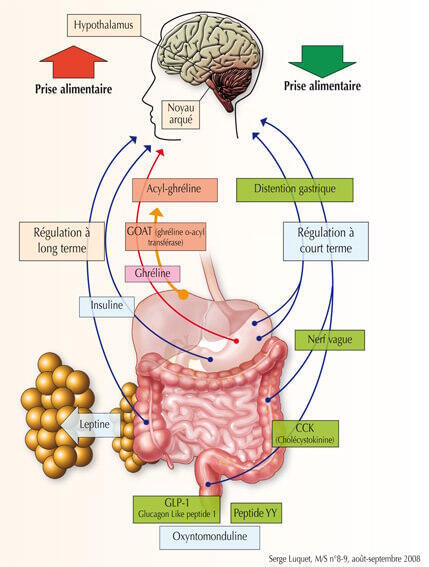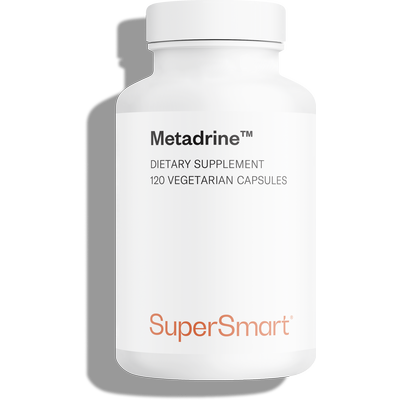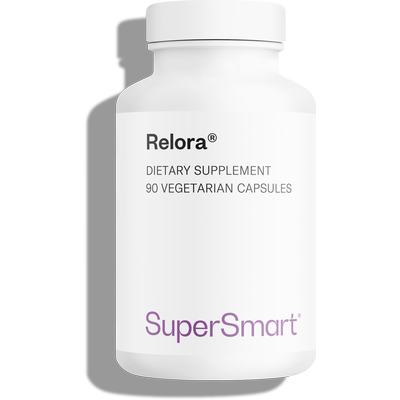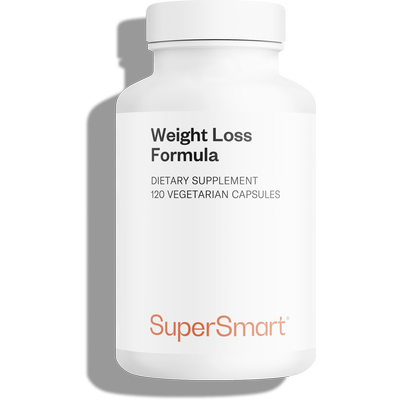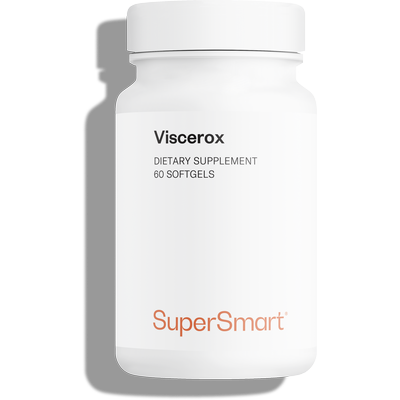Regaining control of your weight
a highly complex problem requiring a multi-faceted approach
Weight gain is almost inevitable with age unless the numerous - and often directly interlinked - mechanisms involved are actively addressed.
In order to retake control of your weight, you must tackle the many elements which regulate food intake and energy output, more specifically, hunger and satiety signals, blood sugar control, fat-burning and fat-oxidation, metabolism and fat storage
This requires a number of different nutrients and ingredients which,depending on their characteristics, have a beneficial effect on one or more of these mechanisms. The root causes of overweight or obesity are complex - it is not just a simple matter of eating too much food and taking too little exercise. As we age, changes occur in our energy expenditure and metabolism which predispose us towards laying down fat stores and gaining weight.
The root causes of overweight or obesity are complex - it is not just a simple matter of eating too much food and taking too little exercise. As we age, changes occur in our energy expenditure and metabolism which predispose us towards laying down fat stores and gaining weight.
The brain, mission control for hunger and satiety
The body has highly sophisticated systems for regulating food intake and fat stores, controlled by the brain. In 1940, research on rats demonstrated that brain damage to the hypothalamus led to lower food and water consumption. In the 1950s, several areas of the brain were identified as being involved in hunger and satiety. Aregion of the hypothalamus called the arcuate nucleus consists of two groups of neurons which produce neurotransmitters that are eitheranorexigenic - appetite-decreasing, or orexigenic - appetite-stimulating.
Most peripheral tissues send nerve or hormonal signals to the brain. In order to maintain energy balance, the brain must constantly pick up and interpret thesehormone, metabolic and nerve signals sent by peripheral tissues involved in the use and storage of energy (liver, muscle, adipose tissue). The brain then sends an appropriate behavioural response (to eat or not to eat) and metabolic response (glucose production by the liver and lipid release by adipose tissue, or energy storage in this same tissue when there is an abundance).
Short term regulation of food intake is controlled by the brain-gut axis: the arrival of food in the stomach results in gastric distension, the receptors in the stomach wall are stimulated and information istransmitted to the central nervous systemvia the intermediary vagus nerve. The arrival of food in the gut releases secretion of hormones including GLP-1 (glucagon like peptide-1), oxyntomodulin and peptideYY which send a message of satiety to the brain. The gut also plays a key partin the absorption and metabolism of lipids.
Long-term regulation of food intake brings in other hormones which themselves send signals to the brain: insulin, produced by the pancreas, which has an anorixegenic effect; leptin, produced by adipose tissue, which activates a signal in the hypothalamus to reduce food intake and increase energy output; and ghrelin, produced by the stomach - the only circulating hormone known to have appetite-increasing properties.
Lowat™ promotes weight loss by increasing levels
of adiponectin and decreasing levels of ghrelin.
Lowat™ is a patented blend of extracts of betel leaf and Dolichosbiflorus seed (horse gram),developed as an aid to weight control. These two plants have been used in traditional medicine in India for centuries.
Lowat™ reducesthe formation and accumulation of fatand increases fat-burning. Results froma clinical study suggest that taking Lowat™ results in weight loss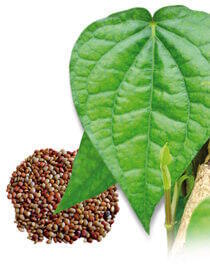 Betel (Piper betle) is a climbing plant, native to India and Malaysia, and part of the Piperaceae family which also includes peppers and kava. Betel is an ayurvedic shrub used for thousands of years to treat diabetes, coughs, indigestion and other health problems. The leaves are normally chewed with lemon and areca nuts. In India and other East Asian countries, betel features in many Hindu rituals and festivals. The leaf juice is taken to ease coughs and indigestion in children. Betel leaf is aromatic, and has a carminative and stimulant effect. When betel leaf extract was administered orally to rats, it led to a significant decrease in blood glucose levels. Betel extract was shown to have a clear beneficial effect on hyperlipidaemia,compared with a control.
Betel (Piper betle) is a climbing plant, native to India and Malaysia, and part of the Piperaceae family which also includes peppers and kava. Betel is an ayurvedic shrub used for thousands of years to treat diabetes, coughs, indigestion and other health problems. The leaves are normally chewed with lemon and areca nuts. In India and other East Asian countries, betel features in many Hindu rituals and festivals. The leaf juice is taken to ease coughs and indigestion in children. Betel leaf is aromatic, and has a carminative and stimulant effect. When betel leaf extract was administered orally to rats, it led to a significant decrease in blood glucose levels. Betel extract was shown to have a clear beneficial effect on hyperlipidaemia,compared with a control.
Horse gram (Dolichosbiflorus) is a small, climbing creeper generally used in ethnobotanicals and as a home remedy' for urinary tract stones, dysuria (painful urination) and haemorrhoids. It was also used to treat kidney stones. Laboratory tests on rabbits given horse gram showed that it has a protective effect in various tissues against oxidative stress induced by a high-fat diet. It also lowers lipids. Horse gram seed powder was believed to have anti-diabetic properties.
Lowat™ was developed after evaluating the effects of over 480 plants on adipocytes or fat cells. Horse gram and betel were shown to be the most effective and together, were even more effective than when used separately. They act on adipogenesis, the formation of fat reserves in the body, thus helping to maximise weight loss. The efficacy of this patented extract has been demonstrated in scientific studies.
One placebo-controlled, double-blind, randomised clinical studyshowed that, when compared with a programme of diet and exercise alone, taking 900mg of Lowat a day (in three, 300mg doses) over eight weeks :
produced a 3-4 times greater reduction in body weight, with weight loss seen after just two weeks' supplementation;
significantly increasedadiponectin, the fat-burning hormone, by 15%;
reduced ghrelin, the appetite-increasing hormone, by 17%;
lowered blood glucose and triglyceride levels..
Ghrelin, the stomach hormone that increases appetite Ghrelin is the hunger hormone, which acts in the brain to stimulate appetite and increase food consumption. Ghrelin levels increase before a meal and decrease after eating. It is considered the antagonistof leptin, produced by adipocytes, which induces satiety.
Ghrelin is the hunger hormone, which acts in the brain to stimulate appetite and increase food consumption. Ghrelin levels increase before a meal and decrease after eating. It is considered the antagonistof leptin, produced by adipocytes, which induces satiety.
According toa recent study presented at the Endocrine Society conference, ghrelin intensifies the desire for high calorie, as opposed to low calorie, food1. In this study, a group of 13 men and 5 women, obese but otherwise healthy, were shown images of food on three different mornings: on one occasion, having skipped breakfast, and on the othertwo mornings, around 90 minutes after eating breakfast. On one of the second two occasions, they were given an injection of salt water (as a control), and on the other, an injection of ghrelin. Neither the researchers nor the volunteers knew which injection they had been given.
No difference in desire for low-calorie food was observed. Those subjects who had eaten breakfast and received a salt water injection found the low calorie food as attractive as the high calorie food. In contrast, when volunteers were given ghrelin after eating breakfast, the high calorie foods, particularly desserts, were more attractive. Dr Tony Gladstone believes that ghrelin mimics fasting by tricking the brain into thinking it needs high-calorie foods. The changes in food preferences we experience when we skip a meal may be explained by fluctuations in blood ghrelin levels which help regulate normal calorie intake. By blocking the action of ghrelin, it may be possible, therefore, to reduce cravings for calorie-rich food and thus promote weight loss in overweight or obese individuals. .
Adiponectin, the fat-burning hormone Adiponectin is a hormone secreted in adipocytes. It plays an important role in maintaining normal metabolism and a healthy weight. Concentrations of adiponectin are lower in cases of obesity, insulin resistance and type II diabetes. They increase with weight loss, suggesting that a decrease in adiposity increases adipocyte sensitivity to insulin.
Adiponectin is a hormone secreted in adipocytes. It plays an important role in maintaining normal metabolism and a healthy weight. Concentrations of adiponectin are lower in cases of obesity, insulin resistance and type II diabetes. They increase with weight loss, suggesting that a decrease in adiposity increases adipocyte sensitivity to insulin.
The weight gain which starts as we reach adulthood is characterised by hypertrophy of adipocytes or fat cells, which begin to store too much fat. Adipocyte size is controlled by genetic transcription factors and is directly related to expression of adiponectin; the lower this expression, the larger the adipose cells.
In addition, research shows that adiponectin has anti-atherosclerotic, anti-inflammatory and anti-diabetic roles. Higher circulating levels of adiponectin protect against coronary artery disease, while lower levels are observed in overweight individuals. Adiponectin's insulin-sensitivising effects suggest it may represent a potential new treatment option for insulin resistance, type II diabetes and obesity.
Controlling appetite
The simplest solution to shedding a few kilos would seem to be: increase energy expenditure or reduce food consumption. However, it's not that straightforward because we have the small matter of hunger to deal with.
The hypothalamus receives every signal relating to desire to eat and satiety: firstly from the stomach, which when empty, manifests as a sensation of hunger; next, from the pancreas, which continuously measures blood sugar levels, and produces insulin to lower them when they become too high. This subsequently leads to hypoglycaemia resulting in,amongst others, a sensation of hunger. A number of transmitters intervene in response to these signals, in particular, adrenalin and noradrenalin.
DMAA (dimethylamylamine) mimics the action of adrenalin and acts on the central nervous system producing an anorexigenic (appetite-reducing) effect. DMAA is found naturally in geraniums. 
Two grass-type plants - Hoodia gordonii and Carallumafimbriata - have been used for centuries by hunters as appetite-suppressants. Hoodia gordonii is used by the Bushmen of South Africa who, by chewing the Hoodia stalk, are able to control hunger and fatigue on long hunting trips. In this way, they can go three or four days without eating or drinking and not suffer any drop in energy levels. Hoodia gordonii contains an active principle which has certain of the same characteristics as glucose. Carallumafimbriata is similarly used by some indigenous peoples in India who chew small pieces of the plant to ward off hunger and thirst on day-long hunting trips. Studies show that Carallumafimbriata acts, in particular, on levels of leptin.
Extract of Irvingiagabonensis counters leptin resistance
Leptin is the signal responsible for long term balance of food intake and energy output and thus the body's total energy stores and weight stability.
In response to an increase in fat reserves, leptin is released by adipocytes to carry out two essential tasks. Via a negative retroaction, it tells the brain to stop consuming foodon the one hand, and increase energy expenditureon the other. It suppresses appetite, thus reducing food consumption and promoting weight loss. It appears to then release a process by which triglycerides stored in adipocytes are converted into fatty acids which can be used for energy production. 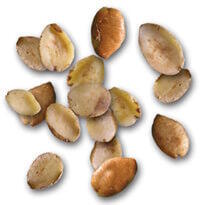 Conversely, the fall in leptin production that results from decreased fat stores sends a command to re-stimulate appetite and reduce energy expenditure, resulting in weight gain. If an overweight or obese individual loses weight by dieting, physical exercise or through illness, the decrease in fat mass is accompanied by a reduction in leptin levels, leading to a restimulation of appetite and a fall in energy metabolism aimed at counteracting the weight loss.
Conversely, the fall in leptin production that results from decreased fat stores sends a command to re-stimulate appetite and reduce energy expenditure, resulting in weight gain. If an overweight or obese individual loses weight by dieting, physical exercise or through illness, the decrease in fat mass is accompanied by a reduction in leptin levels, leading to a restimulation of appetite and a fall in energy metabolism aimed at counteracting the weight loss.
Leptininhibits expression of neuropeptide Y which:
stimulates food consumption ;
r educes thermogenesis ;
increases insulin levels ;
raises cortisone levels ;
through beta-3 adrenergic receptors of the sympathetic nervous system
Leptin therefore leads both to a reduction in food intake, and to increases in thermogenesis and the basal mechanism.
By binding to leptin, C-reactive protein effectively prevents it from fulfilling its task of regulating appetite. Studies have shown that Irvingiagabonensis extract lowers levels of C-reactive protein -responsible for the failure of numerous diets-thus improving leptin resistance, and promoting weight loss. Rhodiolarosea extract and N-acetyl carnitine boost this action by enhancing sensitivity and signalling of leptin receptors.
Fibre offers multiple benefits
Scientific studies have extensivelydocumented the capacity of water-soluble fibre to inhibit absorption of carbohydrates, reduce cholesterol and low-density lipoproteins (LDLs), accelerate feelings of satiety and induce weight loss. A number of plants are rich in water-soluble fibre.
Fibre plays an essential role in health and well-being but modern diets frequently contain insufficient fibre. Plant origin fibre is indigestible but essential for good intestinal transit. A residue and constituent of plant cell walls, fibre comprises a complex mix of carbohydrates known as non-starch polysaccharides. Undigested by the body, fibre passes intact through the digestive tract until it arrives at the large intestine. Soluble fibre helps regulate blood sugar and cholesterol levels. It increases bacterial activity in the colon and when it is broken down by bacteria, substances are produced that stimulate contraction of the intestine, promoting easier elimination of stools from the body. Insoluble fibre retains water, speeds up intestinal activity, reduces transit time and encourages regular motions. By decreasing transit time, it also helps restrict the amount of toxins that can be absorbed. Fibre is a valuable aid to weight loss as it regulates absorption of carbohydrates and fats. It also has a beneficial effect on satiety -it reduces appetite by absorbing water in the stomach. Propolmannan, psyllium, guar, fenugreek and pectin as well as algae such as alginate or carragheen, are all rich sources of water-soluble fibre. Taken with water before a meal, they bind to water in the stomach and small intestine to form a gelatinous, viscous mass which slows down sugar absorption and inhibits reabsorption of intestinal cholesterol excreted by the liver. This gelatinous mass also induces a sensation of satiety and reduces the amount of calories absorbed.
Propolmannan helps to control appetite,andglucose and lipid levels
Propolmannan is a patented, highly purified, natural dietary fibre. It comes from Amorphophalluskonjac, a rare tuberous plant found only in the mountains of northern Japan.
Propolmannan is a water-soluble fibre with a particularly high molecular weight. Using highly specialised technology, it has been reduced to particle size, maximising its density while maintaining a desirable viscosity. A 500 mg capsule of Propolmannan contains significantly more fibre than the same amount from any other plant. The enzymes it contains naturally, which would otherwise cause it to break down during digestion, have been removed.  Used in conjunction with a healthy diet and lifestyle, propolmannan can accelerate weight loss and help regulate blood lipid and glucose levels. A clinical study was conducted on obese young volunteers, in which they were asked to take one gram of propolmannan before each of their three daily meals, without making any other changes to their diet. After eight weeks, they had lost around 4.2kg compared with a placebo group who had only lost on average just over 750g2.
Used in conjunction with a healthy diet and lifestyle, propolmannan can accelerate weight loss and help regulate blood lipid and glucose levels. A clinical study was conducted on obese young volunteers, in which they were asked to take one gram of propolmannan before each of their three daily meals, without making any other changes to their diet. After eight weeks, they had lost around 4.2kg compared with a placebo group who had only lost on average just over 750g2.
In another study, adults supplementing with propolmannanexperienced a significant reduction in blood glucose and lipids. Propolmannan-supplemented volunteers saw their cholesterol fall by 21.7mg/dl, their triglycerides by 23.4 and LDL by 15. In a placebo group, cholesterol and LDL actually increased and triglycerides fell only very slightly. The supplemented volunteers did not change their dietary habits and lost around 2.5 kg at the end of eight weeks, in comparison to the placebo group who saw no significant weight change.
Propolmannanpromotes weight loss :
It absorbs water and quickly expands in the stomach, thus making you feel fuller faster, discouraging calorie consumption.
It prevents the breakdown and assimilation of dietary fats by “absorbing” bile acids in the small intestine, and then transporting them safely out of the body;
It slows the rapid emptying of food from the stomach into the small intestine, reducing the after-meal glucose spike that would normally occur. In this way it restricts weight gain.
Green coffee extract stabilises blood sugar and promotes weight loss
Green coffee contains caffeic acid, ferulic acid and in particular,chlorogenic acid, all of which have strong antioxidant potency. They also play an important role in regulating blood sugar levels because of their ability to inhibit glucose-6-phosphate, the enzyme responsible for glucose production in the liver. Glycerol-5-phospate dehydrogenase is produced in adipocytes to help convert blood sugar - glucose - into triglyceride stores in adipose cells. Controlling this enzyme helps reduce the amount of glucose converted into fatty acids in the blood.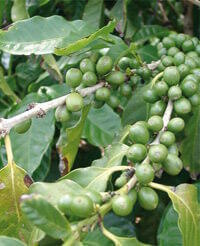 In a study of 75 healthy volunteers, daily supplementation with 90 mg of chlorogenic acid reduced blood glucose levels by 15-20% 3. Chlorogenic acid also has an antagonist effect on glucose transport and reduces its absorption by the gut, thus lowering blood sugar.
In a study of 75 healthy volunteers, daily supplementation with 90 mg of chlorogenic acid reduced blood glucose levels by 15-20% 3. Chlorogenic acid also has an antagonist effect on glucose transport and reduces its absorption by the gut, thus lowering blood sugar.
Green coffee extract promotes weight loss by inhibiting absorption of glucose from the diet and by reducing its assimilation in the small intestine. It also appears to restrict the the liver's ability to produce glucose.
A clinical study conducted on 50 volunteers aged between 19 and 75, with a BMI of more than 25 at the start of the study, showed that green coffee extract induced weight loss. Taking 400mg a day for 60 days led to weight loss of 5.7%4.
Glycaemic peak and weight gain
 When blood levels of insulin and sugar are predominant, lipogenesis (production and storage of fat) and triglyceride production are also stimulated.
When blood levels of insulin and sugar are predominant, lipogenesis (production and storage of fat) and triglyceride production are also stimulated.
In some non-insulin dependent diabetics and overweight individuals, the internal mechanism of glucose release may be over-active, increasing blood sugar to above normal levels. Down-regulating these processes may benefit blood sugar control and, as a consequence, weight loss. An insulin-resistant person not only feels hungry more often but produces and lays down fat more rapidly than someone in good health. They therefore find themselves in a vicious circle - craving carbohydrates, consuming excessive amounts of food, becoming hyperinsulinemic and getting fatter.
L-carnitine de fumarate increases oxidation of fats
L-carnitinefumarate plays an important role in energy metabolism: it is one of the amino acids that transport long-chain fatty acids across the membranes of mitochondria - the cells' powerhouses. Without carnitine, fatty acids cannot easily penetrate the mitochondria which use them to produce energy.
Studies suggest that supplementing with L-carnitinefumarate results in a significant increase in fat oxidation, without altering protein synthesis.5. Animal studies have not demonstrated any weight loss. However, research on human cells suggests that l-carnitine increases oxidation of fats.
Research has demonstrated the importance of L-carnitinefumarate in fat-burning and weight loss. One study investigated the effects of l-carnitinefumarate supplementation on overweight adolescents. It showed that after three months, subjects that ate healthily, exercised and took l-carnitinefumarate lost significantly more weight than those who did not take a supplement.

Fucoxanthin is an effective fat-burner
Canadian researchers recently reported that the decrease in energy expenditure that comes with age may be responsible for the body storing 120-190 excess calories a day, which could translate into 6 - 10kg of weight gain in a year.
Under normal circumstances, chemical energy from food is deposited into adenosine triphosphate (ATP) molecules which are used by the cells as energy. All unused energy from ATP molecules is stored for later use in the form of fat molecules. This is why we put on weight in the form of fat when we take in more calories than we burn.
Thermogenesis is the process by which our bodies produce cellular energy in the form of heat which can be generated without exercise by a mitochondrial protein called UCP1 (mitochondrial uncoupling protein 1).
Fucoxanthin, a carotenoid, is the brown pigment found in abundance inUndariapinnatifida or wakamé, the brown seaweed used in Japanese salads and miso soup . Researchers from the University of Hokkaido in Japan demonstrated that fucoxanthin is very effective at burning fat. In their work on mice, the Japanese scientists showed that by stimulating production of a protein, UCP1, which can oxidise and promote breakdown of fats, fucoxanthin contributed to weight loss of 5-10%. This research also demonstrated that it stimulated liver production of DHA (docosahexaenoic acid), an omega-3 fatty acid known to reduce levels of bad' LDL cholesterol)6, 7.
Two double-blind, placebo-controlled studies on 150 overweight women tested the effects of fucoxanthin combined with an 1800 cal/day diet. Volunteers were monitored for 16 weeks. In the first trial, the fucoxanthin-supplemented group lost an average 7kg compared with only 1.5kg in the placebo group. In the second study, the metabolic rate of the volunteers taking fucoxanthin was measurably higher than that of the placebo group.
Guggulsterones from Commiphoramukul regulate fat cells
Guggulsterones, extracted fromCommiphoramukul, have been used for thousands of years in ayurvedic medicine to treat arthritis, inflammation, bone fractures, excess weight andproblems with lipid metabolism . Guggulsterones activate lipolytic enzymes and increase levels of the thyroid hormone T3, probably by increasing conversion of T4 into T3 in the liver and by directly stimulating the thyroid. Their capacity for stimulating the thyroid may partly explain why they affect cholesterol levels and promote weight loss.
Guggulsterones activate lipolytic enzymes and increase levels of the thyroid hormone T3, probably by increasing conversion of T4 into T3 in the liver and by directly stimulating the thyroid. Their capacity for stimulating the thyroid may partly explain why they affect cholesterol levels and promote weight loss.
In one study, subjects followed a 6-week programme of diet, and exercise and some were givena nutritional supplement containing guggulsterones. The supplemented group lost almost 5kg, compared with only 1.5kg in the unsupplemented group. At the same time, their thyroid activity rose by 8-10 %.8.
A cell study examining the effects of guggulsterones on fat cells showed that they exert an anti-obesity effect by inhibiting differentiation of pre-adipocytes, inducing apoptosis and promoting lipolysis of mature adipocytes. They may therefore play an important role in tackling obesity, by regulating the number and size of fat cells9.
Increasing energy output by stimulating thermogenesis
Thermogenesis can be stimulated by certain nutrients. When it is stimulated, energy output increases and so less excess energy remains to be stored in the form of fat.
Basal metabolism corresponds to the body's fixed energy needs - in other words, the minimum amount of energy necessary for survival. At rest, the body uses energy to maintain vital functions (heart, brain, respiration, digestion, body temperature). Basal metabolism depends on a number of factors, including height, weight, age, gender and thyroid activity. Basal metabolism is also influenced by climatic conditions and external temperature.
Basal metabolism decreases as we age; by adulthood, the rate of decrease is 2-3% every 10 years. Drastic dieting also lowers basal metabolism resulting in the body laying down more fat reserves, thus promoting weight gain. Regular exercise, on the other hand, helps maintain basal metabolism at normal levels. Restricting food intake without exercising will lower basal metabolism.
Thermogenesis is the principal mechanism of heat production and thermoregulation. Metabolic heat is generated from the beta-oxidation of fatty acids drawn from triglyceride stores which form in brown adipose tissue. This metabolic heat generation is induced by the action of noradrenalin as well as by the body's response to cold.
Animal studies have shown that thermogenesis falls significantly with age. Researchers have hypothesized that this fall may be due to a reduction in beta-oxidation of lipids by brown adipose tissue.
When overweight individuals change their dietary habits and lose weight, their bodies want to maintain fat stores and try to minimise these changes. If calorie intake is reduced, the metabolic rate slows to try and preserve fat stores. It is the body's natural response to preventing starvation.
A number of different nutrients enable the stimulation of thermogenesis, among them, polyphenols from green tea and extracts of citrus fruits, Capsicum annum, fucoxanthin, Garciniacambogia and theobromine from cocoa.
5-hydroxytryptophan, a precursor of serotonin, helps control appetite
5-hydroxytryptophan (5-HTP) is the precursor of the inhibitory neuromediator serotonin. It is often used to counteract the bulimic effects associated with stress. It also counters the stimulant effect of the formulation's other ingredients. Studies show that serotonin affects eating behaviour and body weight. Low levels are found in obese people and are associated with a strong desire for, and high consumption of, carbohydrates. An increase in plasma levels of serotonin is associated with a reduction in both food consumption and weight, and an increase in energy expenditure10.
Four studies on obese patients showed that supplementation with 5-HTP leads to reduced food intake, and therefore, weight loss.
7-keto DHEA acts on thermogenesis
The term 7-KetoDHEA® is a brand name for the chemical compound 3-acetyl-7-oxo-dehydroepiandrosterone, a naturally occurring DHEA metabolite primarily produced in the adrenal glands and skin (though some production occurs in the brain as well).
7-keto® stimulates activity of three thermogenic enzymes which accelerate oxidation of fatty acids in the liver: fatty acyl CoA oxidase, malic enzyme, and glycerol-3-phosphate dehydrogenase. These enzymes drive the liver cells to burn fatty acids, which causes a decrease in triglycerides in the liver. Studies show that supplementation with 7-keto® significantly stimulates levels of these enzymes : fatty acyl CoA oxidase increased by 128%, malic enzyme jumped 860% and glycerol-3-phosphate dehydrogenase increased by 138%12.  A clinical study of healthy subjects showed statistically significant losses in weight and body fat, after four and eight weeks, in a supplemented group but no such effect in a placebo group. At the 8th week, the group receiving 7-keto® had lost almost 3kg and 1.3% of body fat.
A clinical study of healthy subjects showed statistically significant losses in weight and body fat, after four and eight weeks, in a supplemented group but no such effect in a placebo group. At the 8th week, the group receiving 7-keto® had lost almost 3kg and 1.3% of body fat.
A statistically significant increase in thyroid hormone T3 activity was also noted. The T3 did not increase beyond normal, acceptable values.
The thyroid hormone T3 is a powerful metabolic stimulant and this degree of elevation probably increased the metabolic rate of the volunteers. These findings suggest that 7-keto® can significantly - and completely safely - reduce fat mass and body weight when combined with a low calorie diet and exercise, due to the large increase in levels of fat-burning enzymes in the liver and the thyroid elevation13.
A clinical study involving 45 subjects was conducted to evaluate the effect of 7-keto® on resting metabolic rate. Results showed that supplementing overweight adults with 7-keto®, in conjunction with calorie restriction, reversed the decline in resting metabolic rate normally associated with dieting. The 7-keto®, combined with calorie restriction, led to an increase in resting metabolic rate of 1.4% above basal rate, compared with a decrease of 3.9% in the group following a low calorie diet only14.
The dangers of abdominal fat
Excess abdominal fat is not only unattractive but may also be a sign of metabolic syndrome which increases the risk of cardiovascular disease, stroke and diabetes. Abdominal fat contributes to metabolic syndrome in two ways because it consists of two different metabolic types, each transported to different areas. Subcutaneous fat which accumulates beneath the skin can be unattractive but is not dangerous. Visceral fat, found deeper in the abdominal cavity, is, according to research, a ticking timebomb'. It is found under the muscles and surrounds vital organs. Progressive accumulation of visceral fat is a cause of insulin resistance, one of the first metabolic disturbances that lead to metabolic syndrome. Visceral fat cells are metabolically active and produce a wide range of peptide hormones such as angiotensin, and inflammatory cytokines such as C-reactive protein and interleukin-6 (IL-6), which act on other cells to produce inflammation. Angiotensin acts as a chemical mediator or a signalling peptide which can raise blood pressure caused by constriction of peripheral blood vessels. Even a slight increase in visceral fat can also produce measurable inflammation in the endothelial cells covering the blood vessels. Studies have shown that glabridin, the most abundant flavonoid in liquorice root Glycyrrizaglabra L., reduces visceral fat. It also has antioxidant and blood sugar-lowering properties. Glabridin down-regulates fat production, while increasing activity of the enzymes responsible for breaking down adipose tissue. An eight-week, placebo-controlled study, designed to determine an effective dose of flavonoidsfrom liquorice root oil, tested 300, 600 and 900 mg a day on overweight volunteers (56 men and 28 women). In the group taking 900 mg, a significant reduction in body weight, body mass index and fat mass was observed after four and six weeks of supplementation15.
Studies have shown that glabridin, the most abundant flavonoid in liquorice root Glycyrrizaglabra L., reduces visceral fat. It also has antioxidant and blood sugar-lowering properties. Glabridin down-regulates fat production, while increasing activity of the enzymes responsible for breaking down adipose tissue. An eight-week, placebo-controlled study, designed to determine an effective dose of flavonoidsfrom liquorice root oil, tested 300, 600 and 900 mg a day on overweight volunteers (56 men and 28 women). In the group taking 900 mg, a significant reduction in body weight, body mass index and fat mass was observed after four and six weeks of supplementation15.
Une crème pour lutter contre la cellulite
 Cellulite affects 80-95% of women, irrespective of their weight (a third of women with cellulite are slim). Deposits of subcutaneous fat give the skin an irregular, dimpled and unsightly appearance. These deposits are concentrated on the thighs, buttocks and hips.
Cellulite affects 80-95% of women, irrespective of their weight (a third of women with cellulite are slim). Deposits of subcutaneous fat give the skin an irregular, dimpled and unsightly appearance. These deposits are concentrated on the thighs, buttocks and hips.
Cellulite literally means inflammation of the cells butin factcorresponds to an increase in the number and size of adipocytes where fat accumulates in the hypodermis. Additional factors are water retention linked to poor blood and lymphatic circulation and possible hormone imbalances between oestrogen and progesterone which affect capillary permeability. Finally, peri-adipocyte fibrosis can develop over time. The surrounding connective tissue becomes inflexible as glucose binds to collagen fibres. The supporting tissue changes and ages more quickly.
Daily use of a cream rich in active principles that act on these different elements - maturation of adipocytes, storing of fat and blood circulation - can significantly improve the appearance of the skin.

------------------------------------------------------------
References :
---------------------------------------------------------
Références :
1. Goldstone T., Fasting biases brain reward systems towards high-calorie foods. Metabolic Molecular Imaging Group MRC Clinical Sciences Centre, Imperial College London, June 2010.
2. Rodriguez de Roa et al., Pharmacologic intervention program in infantile obesity and dyslipidemias : usefulness of dietary fiber LuraLean. Unpublished study.
3. Abidoff M. T., Special clinical report on effects of glucose-6-phosphatase on human subjects. Russian Ministry of health. Moscow, 1999, unpublished study.
4. Dellalibera O. et al., Svetol, green coffee extract induces weight loss and increases the lean to fact mass in volunteers with overweight problems. Phytotherapy. Vol. 4, N° 4, 2006 November.
5. The effect of l-carnitine on fat oxidation, protein turnover and body composition in slightly overweight subjects. Metabolism. 2004 Aug. ; 53(8) : 1002-6.
6. Miyashita K., American Chemical Society annual Meeting, San Francisco, 10-14th September 2006.
7. Miyashita K. et al., Fucoxanthin from edible seaweed, Undaria pinnatifida, shows antiobesity effect through UPC1 expression in white adipose tissues. Biochemical and biophysical research communication 332(2005) 392-397.
8. Antonio J. et al., Effects of a standardized guggulsterones phosphate supplement on body composition in overweight adults : a pilot study. Current therapeutic Research Clinical and Experimental, 1999, 60 : 2220-227.
9. Yang J. Y. et al., Guggulsterone inhibits adipocyte differentiation and induces apoptosis in 3T3-L1 cells. Obesity (2008 : 16, 16-22. doi:10.1038/oby.2007.24
10. Leibowitz S. F. et al., Hypothalamic serotonin in control of eating behavior, meal size and body weight. Biol. Psych. 1998 ; 44:851-864.
11. Lardy H. et al., Ergosteroids : induction of thermogenic enzymes in liver of rats treated with steroids derives from DHEA, Proc. Natl. Acad. Sci. USA, 1995 Jul. 3, 92(14) : 6617-9.
12. Lardy H. et al., Ergosteroids. II : Biological active metabolites and synthetic derivatives of DHEA, Steroids, 1998 March, 63(3) : 158-65.
13. Kalman D. S. et al., A randomized, double blind placebo-controlled study of 7-keto in healthy overweight adults, Curr. Therap. Res., 2000, 61(7) : 435-42.
14. Zenk J. L. et al., A prospective, randomized, double blind study to evaluate the effect of HUM5007 and 7-oxo-DHEA on resting metabolic rate in overweight adult men and women on a caloric restricted diet ; abstract presented at the meeting on the FASEB, April 17, 2004.
15. Aoki F. et al., Clinical safety of licorice flavonoid oil (LFO) and pharmacokinetics of glabridin in healthy humans. Journal of the American College of Nutrition, 2007. Vol. 26, n° 3, 209-218.
All rights reserved
Free
Thank you for visiting our site. Before you go
REGISTER WITHClub SuperSmart
of exclusive benefits:
- Free: our weekly science-based newsletter "Nutranews"
- Special offers for club members only



